For many campers, RVing is about being outside, relaxing in nature, and finding peace in the beauty of the outdoors. While some campers enjoy the outdoors at traditional RV parks with full hookups and free WiFi, others opt to rough it with boondocking. But knowing the basics of boondocking can be useful for any camper—it’s cheap, convenient, and gives you access to incredible views you otherwise might not see.
In this article:
- What to know before you go boondocking
- Electricity while boondocking
- Water while boondocking
- Internet while boondocking
- Safety while boondocking
- The best RVs for boondocking
- Boondocking tips for beginners
- Where to find boondocking sites
- Boondocking apps and websites
- Boondocking gear
What Is Boondocking in an RV?
Boondocking in an RV is when you camp without hookups to electricity, water, or sewage. You can boondock in many different ways, like staying overnight in a business parking lot or camping on public lands. Most of the time when campers talk about boondocking, they’re referring to camping in national forests or on BLM (Bureau of Land Management) land. Boondocking in this way is sometimes referred to as wild, primitive, or dispersed camping and often comes with Instagram-worthy views.
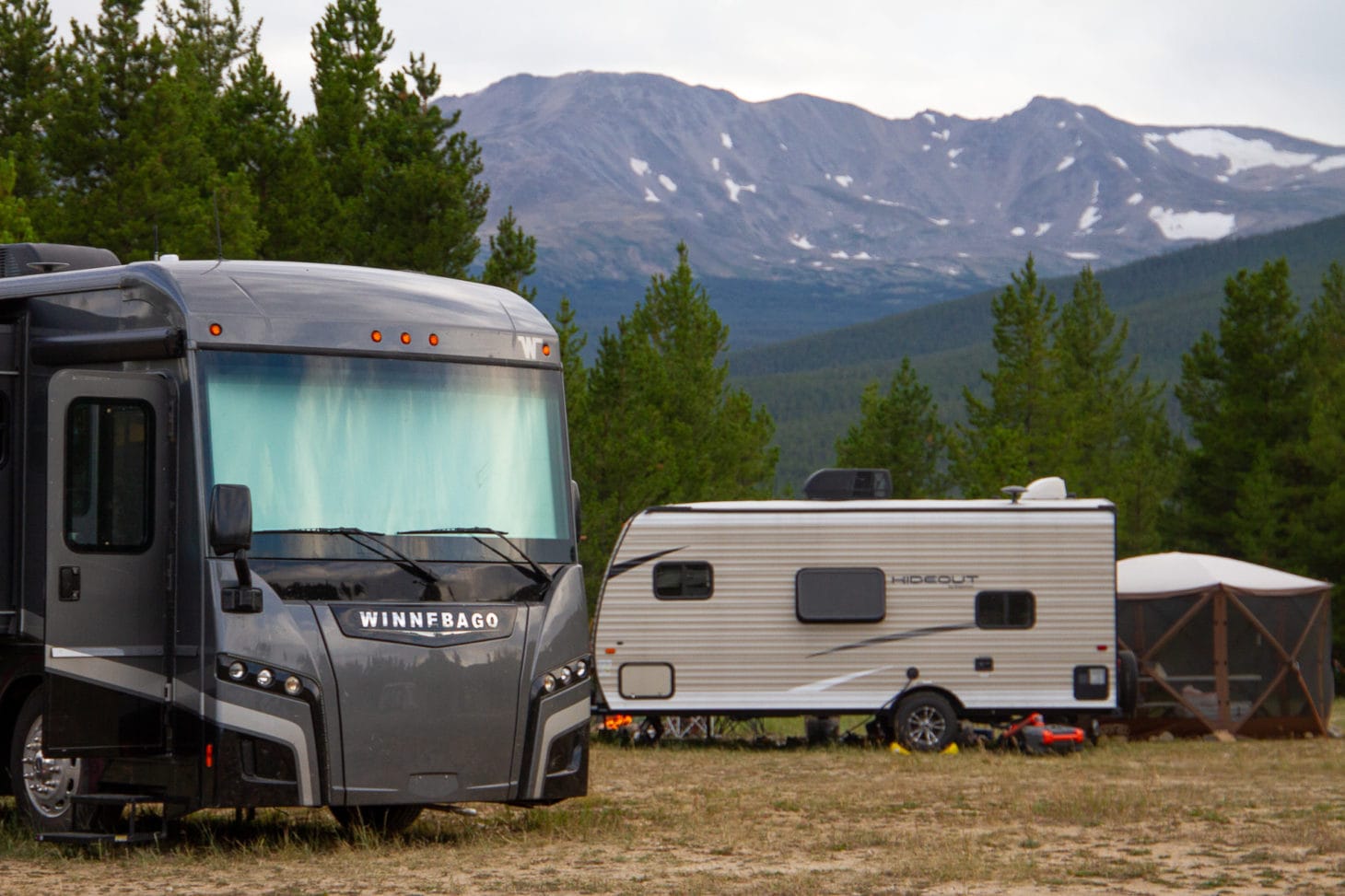
Because your RV isn’t hooked up to electricity, boondocking is popular during months and in areas where temperatures aren’t extreme, like the mountains of Colorado in the summer and the deserts of Arizona in the winter. Air conditioners and furnaces require too much power to temperature control an RV during extreme heat or cold, making it difficult to boondock in many areas throughout the year.
Most often, boondocking is free, which makes it a great way for campers to save money and experience unspoiled nature. Some boondocking sites may charge a small overnight fee, but this is typically less than $20 per night. Boondocking sites tend to be first come, first served, and do not require reservations.
Dry camping is often confused with boondocking. But while both terms describe camping without hookups, the term boondocking is almost exclusively used for camping outside of designated campgrounds. Dry camping is often more expensive than boondocking because campgrounds typically have amenities like public bathhouses and paved roads, which boondocking areas rarely offer.
What to Know Before You Decide to Go Boondocking
Before heading out into the wilderness, always check the weather forecast, even if you’re only boondocking for one night. Temperatures between 40 and 70 degrees Fahrenheit are ideal in order to avoid having to run A/C or a heater.

Rains can flood or wash away access roads, unexpected mountain snow storms can trap you, and wildfires can close public lands. You should also note weather conditions for the days leading up to your arrival at a campsite, as heavy rains could mean a muddy campsite or impassable roads.
How Long Will You Be Boondocking?
If you’re only boondocking overnight, you won’t need to do too much prep. With a little water in the freshwater tanks and a single power source, you can easily make it through the night.
But if you’re attempting a few days or more—the maximum boondocking limit on most public lands is two weeks—you’ll need to address your resource needs to ensure your home on wheels can sustain itself off-grid.
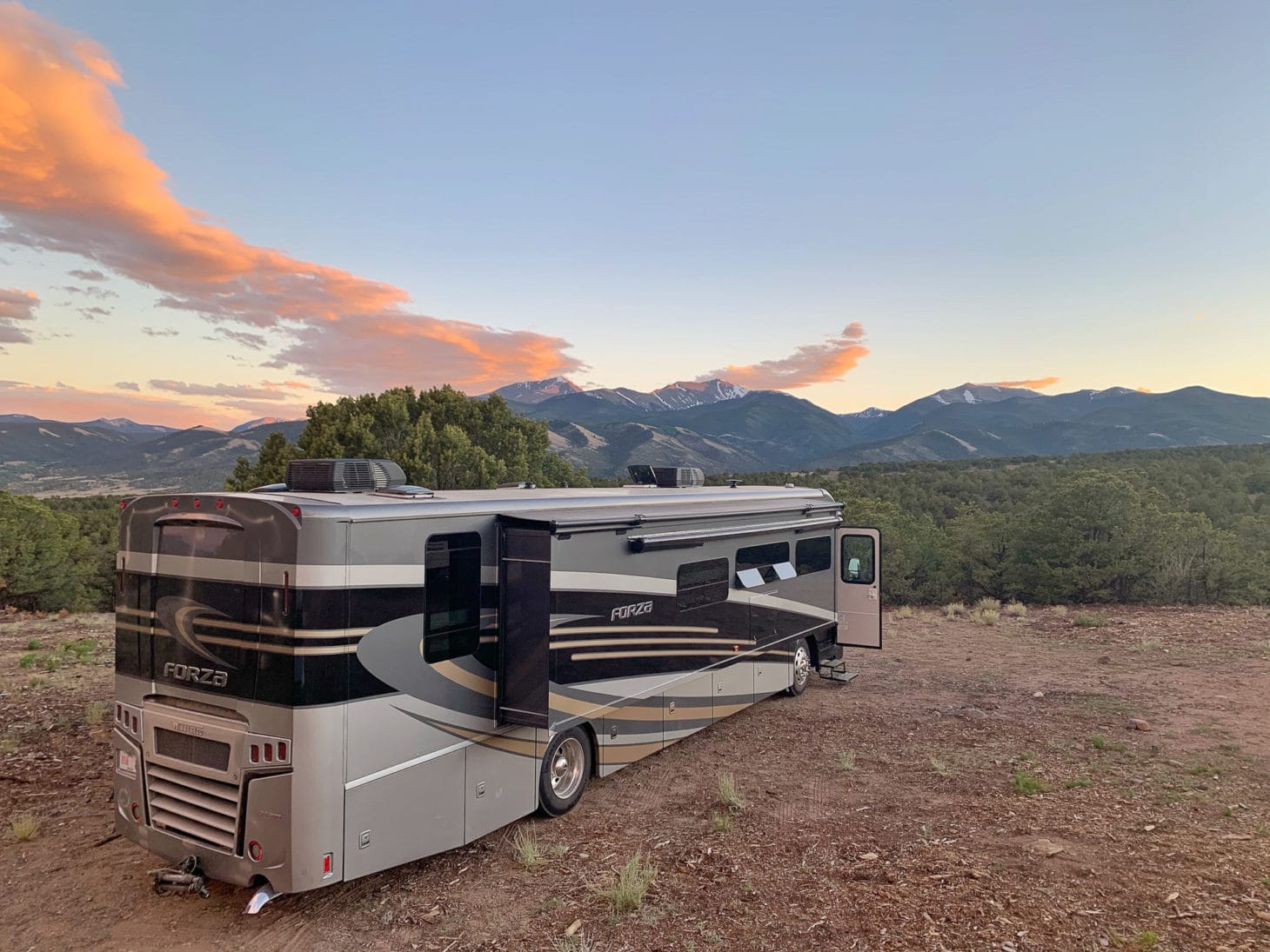
Electricity While Boondocking
Electricity without hookups is much more complicated than plugging in your RV at a traditional campground. You’ll need one or more power sources to run your appliances and outlets.
Option 1: Generators
Generators are the most common supplemental power source because they’re built into many larger motorhomes and are incredibly easy to use. However, most trailers, fifth wheels, and smaller campers won’t come equipped with a generator, so you’ll need to consider purchasing one.
If you’re looking for a boondocking power source that can easily run your microwave or A/C units, generators are your best option.
In motorhomes, the generator is most likely connected to your fuel line. So if you have a gas rig, your generator will pull gas from your tank. If you have a diesel rig, it will pull diesel from your tank. In this case, there is a failsafe in the generator that will turn itself off if your fuel level dips below a quarter of a tank. That way you don’t run out of gas and end up stranded.
The con for any generator is the carbon footprint, since you’ll be burning gas and creating toxic fumes. Also be aware of safety concerns and don’t leave your windows open while the generator is running.
Environmentally speaking, generators aren’t the best option, but they provide you with strong and stable power. And because of how little gas they use, they’re also an economical option. However, some boondocking sites do not allow generators, so you may require a quieter electricity setup.
Option 2: Batteries and Inverters
Another option is to use extra heavy-duty RV and deep cycle marine batteries connected to an inverter to power items like your fridge and outlets. This extra power should be enough to charge a laptop, watch TV, or even use a slow cooker to prep dinner.
While standard batteries may be able to shoulder the heavy pull of a coffee maker or microwave, they aren’t meant for heavy usage appliances. High-voltage use will zap your available power and wear down battery life quickly. With the additional batteries and inverter, you can use your outlets at any time, without powering on a generator.
An inverter is not a reliable long-term power source because you will need a way to recharge the batteries. Batteries can recharge in three ways: running the engine, running the generator, or plugging into shore power. If you have solar on board, this can also recharge your batteries.
Option 3: Solar
Solar setups are likely used in conjunction with batteries and an inverter. It’s the most environmentally-friendly and reliable power source for long-term boondocking.
However, you need the sun. This means you won’t be able to camp in the shade and you’ll want to pay closer attention to weather patterns to make sure you’re getting enough sunshine to replenish your batteries.
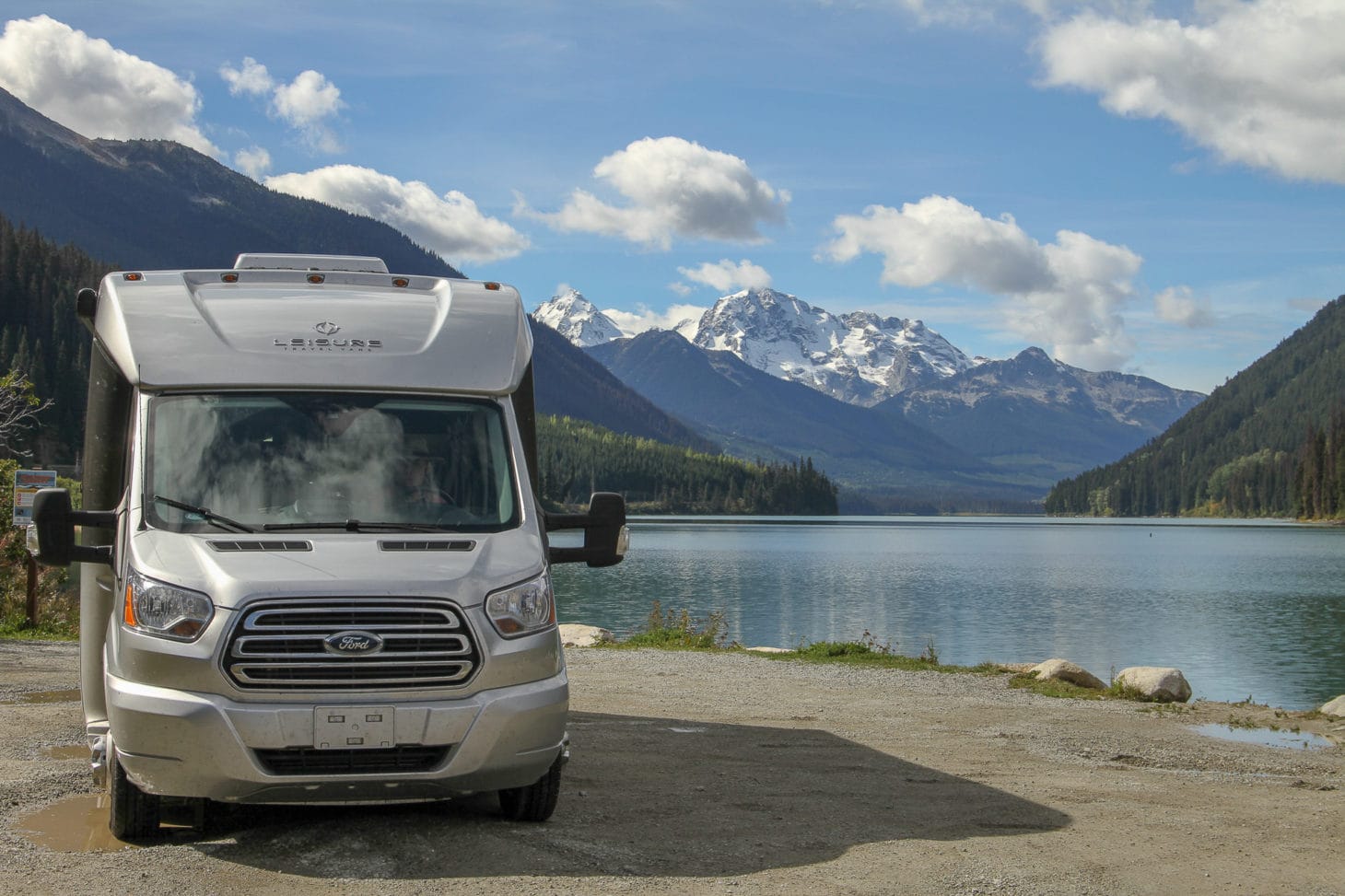
Water While Boondocking
There is no set number of gallons of water needed for boondocking, but you should fill your water tank to 100 percent and empty your black and gray tanks before your trip. For extended boondocking, you can purchase a water bladder to top off your water tanks.
There are a few main activities that will drain your water: regular bathroom use, showers, and dishes.
Most boondocking sites will not have bathroom facilities and in some places, you cannot boondock without having a self-contained bathroom on board (this is more common outside of the U.S.). Unless you plan on burying your waste (6 to 8 inches deep and at least 200 feet from trails, water sources, and campsites), you’ll use your onboard toilet. If you’re camping in a converted vehicle without a built-in bathroom, you can buy portable toilets from any camping store. You can cut down on using water in the bathroom by using public facilities throughout the day or investing in a composting toilet.
Showering can also be difficult when boondocking. When available, opt for showering at a local gym, national park bathroom, or jump in a lake. Or skip showers altogether in favor of wipes. Companies like Epic Wipes and Venture Wipes make biodegradable wipes that get you clean, save water, and don’t have a negative impact on the environment.
Washing dishes is also a drain on water, but there are a few ways to cut down on what ends up in the sink. Use paper plates, grill instead of using pots and pans, or meal prep before boondocking so you don’t cook as much—this also saves power and propane. The most efficient way to wash your dishes is to fill one side of the sink with warm, soapy water and wash the whole day’s dishes at once. This way you aren’t constantly running water to wash dishes individually.
In many RVs, the gray tank (or tanks) is slightly bigger than the freshwater tank, but if you add water, you may need to dump your gray tank at a local dump station.
Some RVers will dump gray tanks on the ground while boondocking. This is frowned upon and not encouraged. You should never under any circumstances dump your black tank anywhere except at a designated dump station, and you should always pack out your trash to be disposed of properly.
Internet While Boondocking
If you’re working in the wild or want to stay connected, check potential internet connectivity using sites like Campendium or Allstays which report area cell signal strength. You won’t find any public WiFi in dispersed camping areas, but you can still stay connected with the right internet setup, like using cellular data and a cell phone signal booster.
Safety When Boondocking
Before heading out, check in with a friend or local park ranger to let them know your plans, like where you’re camping and for how long.
There are a few major safety concerns while boondocking, including animals. Most boondocking areas in the U.S. are located in the West, which means predators like bears and mountain lions as well as elk and moose are potential threats. Be aware that you’re a visitor on territory that isn’t frequented by humans. This means following “bear aware” rules like securing food or cooking items behind locked doors and maintaining a respectful distance from large animals. It’s important to be especially diligent when you see animals with their young or during mating season.
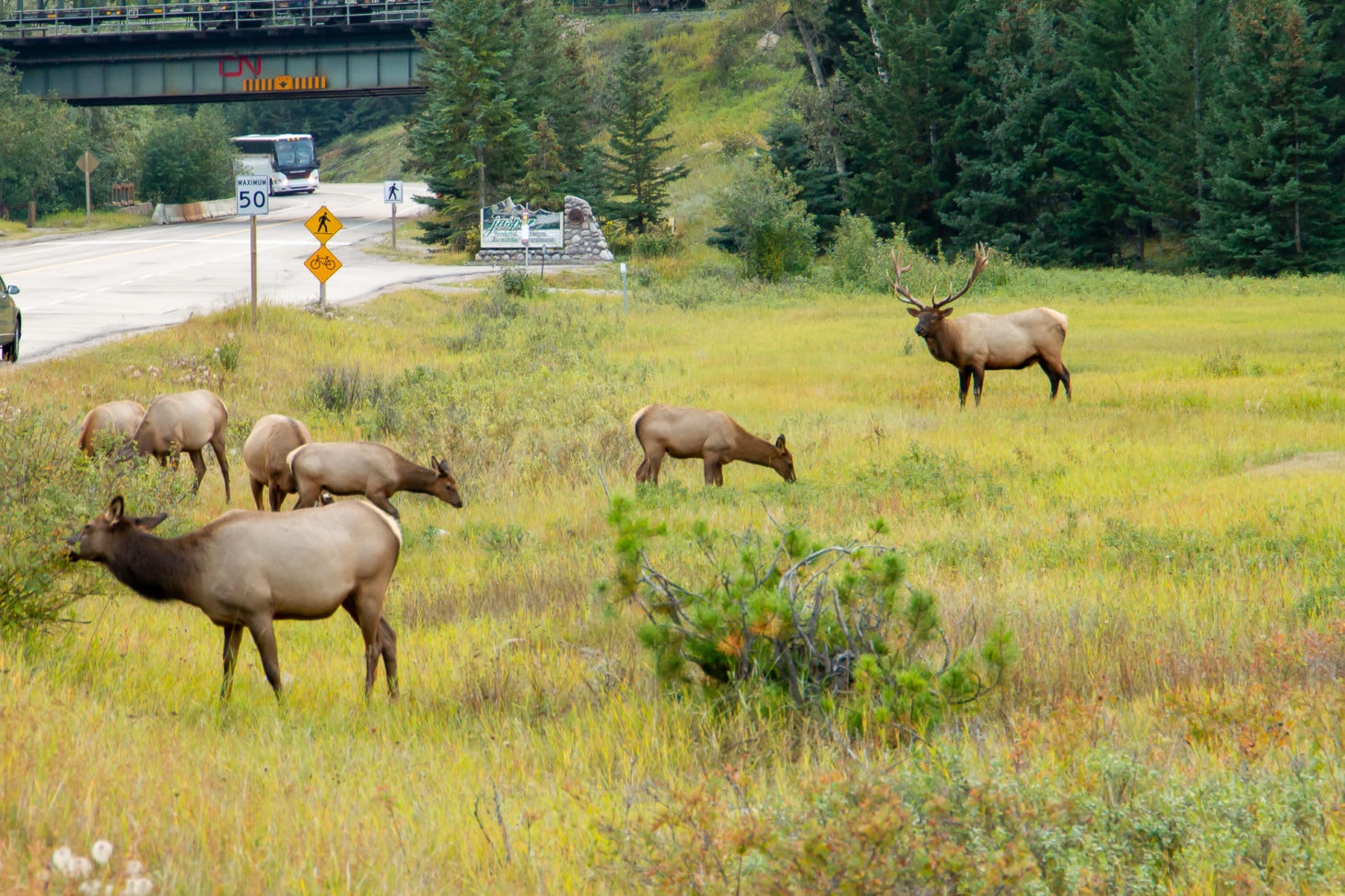
Weather is another safety concern. Inclement weather can occur suddenly, especially in the mountains. If you’re boondocking without internet or a cell signal, save or print the week’s weather forecast for reference.
You can also easily get stuck in your RV due to bad weather. We’ve been stuck in the mud after heavy rains and friends were trapped on a mountain after a surprise July snowstorm. If there’s a chance of bad weather and you still decide to boondock, stock the rig with an extra day’s worth of supplies.
The Best RVs for Boondocking
There’s no single RV that is the best for boondocking, but some RVs are built with boondocking in mind and include key features you should look for while shopping.
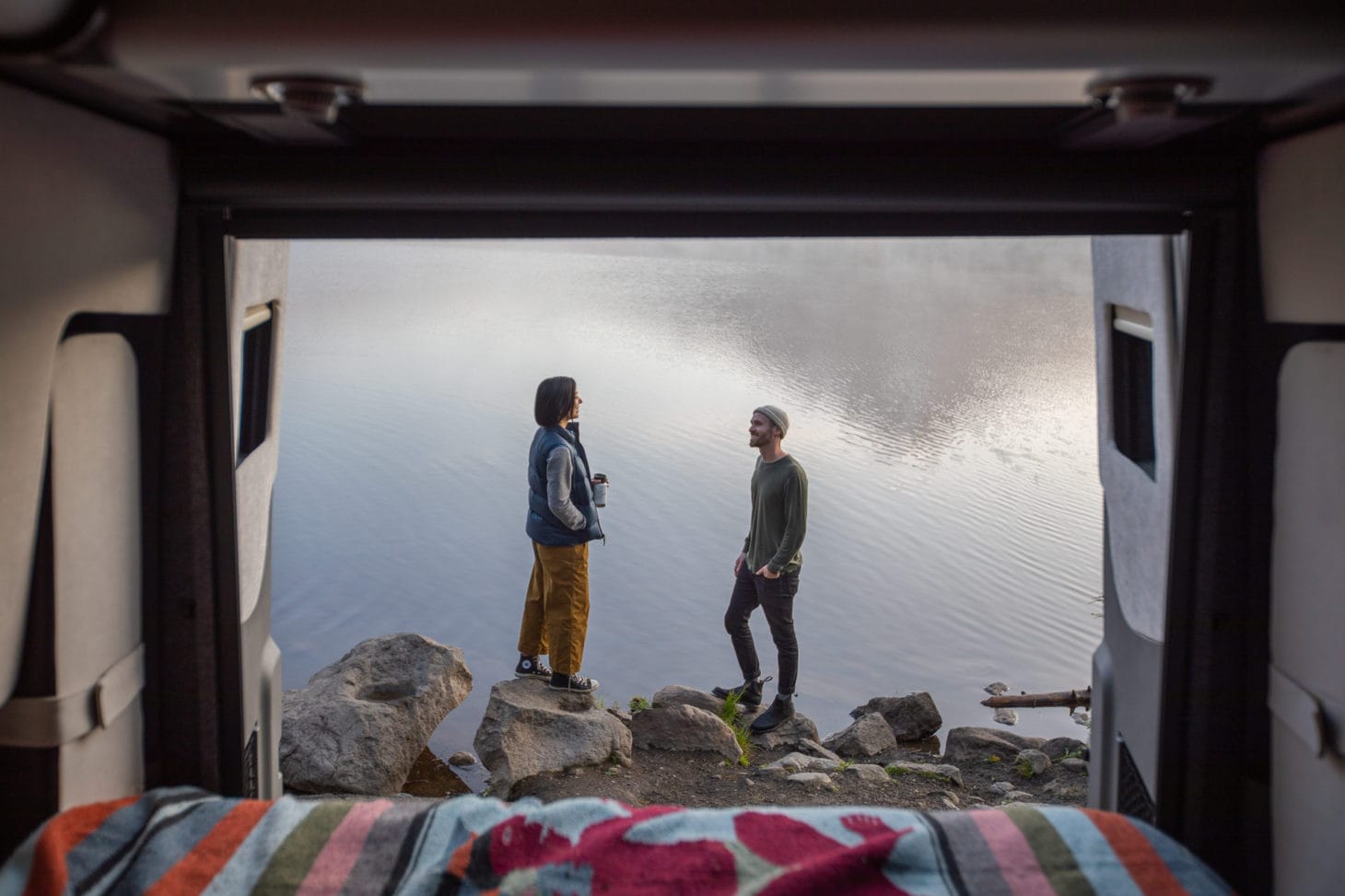
Power Sources
RVs with solar power, batteries, and an inverter on board are ready to boondock instantly. Some RVs will come “solar ready” which means the batteries and inverter are installed, and there’s space on the roof for panels. Solar energy will charge and store in your batteries, so a larger battery bank allows for longer boondocking trips. When rig shopping, ask about solar options as well as the size of the available battery bank. Check to see if the RV has an onboard generator as well.
Notable RVs:
Airstream Basecamp, Keystone Super SolarFlex, and Winnebago Ekko
Appliances and Refrigerators
Appliances like an oven or microwave pull a lot of power. If you’re planning on extensive boondocking, you’ll want to choose the most energy-efficient appliances possible, like a gas oven instead of a convection oven.
You should also examine the refrigerator while you shop. There are three types of refrigerators commonly found in RVs: two-way (also referred to as an absorption fridge), three-way (also referred to as a compressor fridge), and residential.
Two-way and three-way refrigerators require the least amount of power and are better suited for boondocking. These 12V refrigerators will pull a minimal amount of power and can run off propane when boondocking.
Residential fridges are great for full-time RVing, but harder for boondocking because they require a lot of battery power to operate. If you have a residential fridge, you’ll need plenty of solar energy to recharge your batteries, or an onboard generator to shoulder the additional power.
Notable RV:
Tank Sizes
You can find large tanks on rigs of any size, so choosing the right one for you depends on a few factors. How often will you be boondocking? How many people will be with you? How far off the grid do you want to go?
For solo off-grid camping, a van or small motorhome is ideal because of its size, and a smaller 40-gallon tank holds plenty of water. For a family with kids, a fifth wheel or trailer with larger tanks that can support more people is important. For reference, a 100-gallon freshwater tank in a Class A diesel motorhome can last for up to a week when used conservatively by a family of three.
Notable RV:
Wheelbase and Clearance Height
Some boondocking locations are far off the beaten path. This means dirt roads and rough driving. When possible, use your tow car to scout these locations before you camp.
As you shop for an RV, look at its ground clearance and wheelbase to determine how well it handles off-roading. Smaller motorhomes and campers are designed specifically to handle off-roading or can be modified with off-road tires to give it an additional lift.
Notable RV:
Length and Weight
National forest and BLM roads are often unpaved or not maintained, and may have vehicle length or weight limitations. This can make it difficult for larger RVs, specifically motorhomes, to access these sites.
If you’re planning on primarily using your RV for boondocking, a smaller RV (a Class C or B motorhome, van, truck camper, teardrop, or small trailer) that’s under 30 feet will allow you to access more remote places. This isn’t to say that you can’t boondock in a big rig, but it can be more difficult. Use apps like Campendium to learn if bigger rigs can access specific camping areas.
Notable RV:
Boondocking Tips for Beginners
Boondocking can be intimidating, especially for first-timers. Preparation is key and you’ll probably make a mistake or two, which you can learn from for your next boondocking excursion.
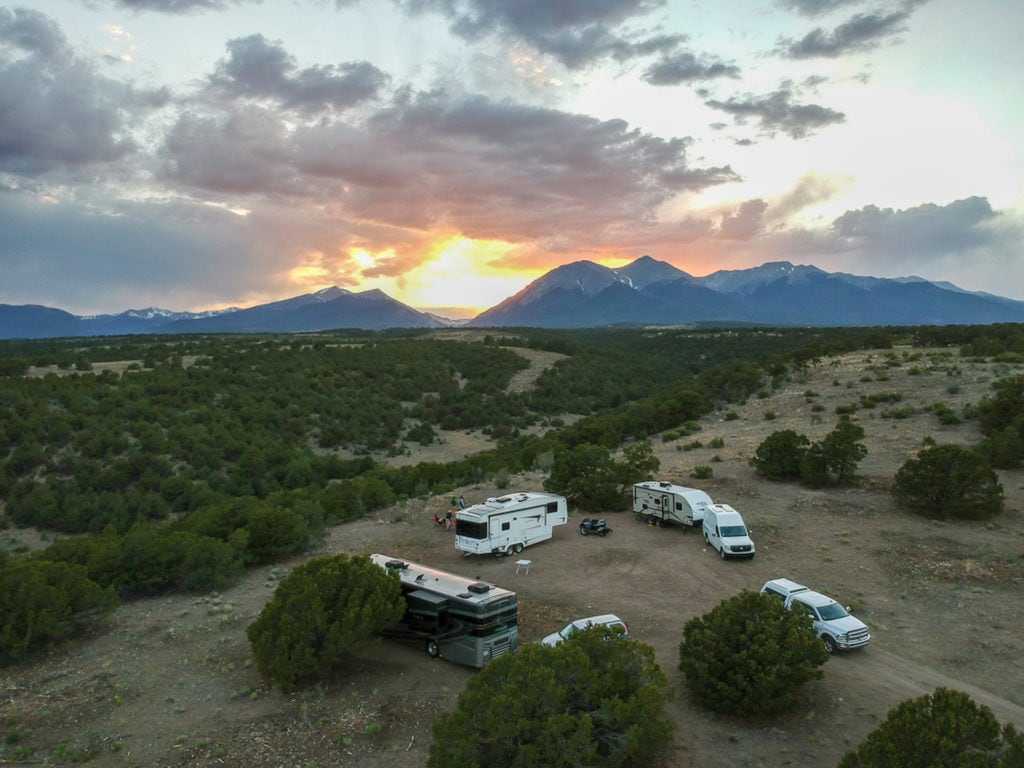
Here are some essential tips for first-time boondockers:
- Have fresh water in your tank.
- Arrive during daylight.
- Double-check the weather forecast. (If the weather is going to dip below freezing, make sure you’re prepared.)
- Check if the camping area has designated generator hours and plan accordingly.
- If using solar panels, make sure you have an inverter.
- Bring along small appliances, like a stovetop espresso maker, that use limited power.
- Charge up phones, laptops, and camera batteries ahead of time.
- Be conservative with your power use to keep batteries healthy, save on gas, and run your generator less.
- Stock up on groceries.
- Do laundry ahead of time.
- Pack extra supplies in case you need to stay longer than planned.
Where to Find Boondocking Sites
Due to local laws and the need to protect federal lands, boondocking does come with some legal concerns, so it’s important to make sure you’re parking your rig legally.
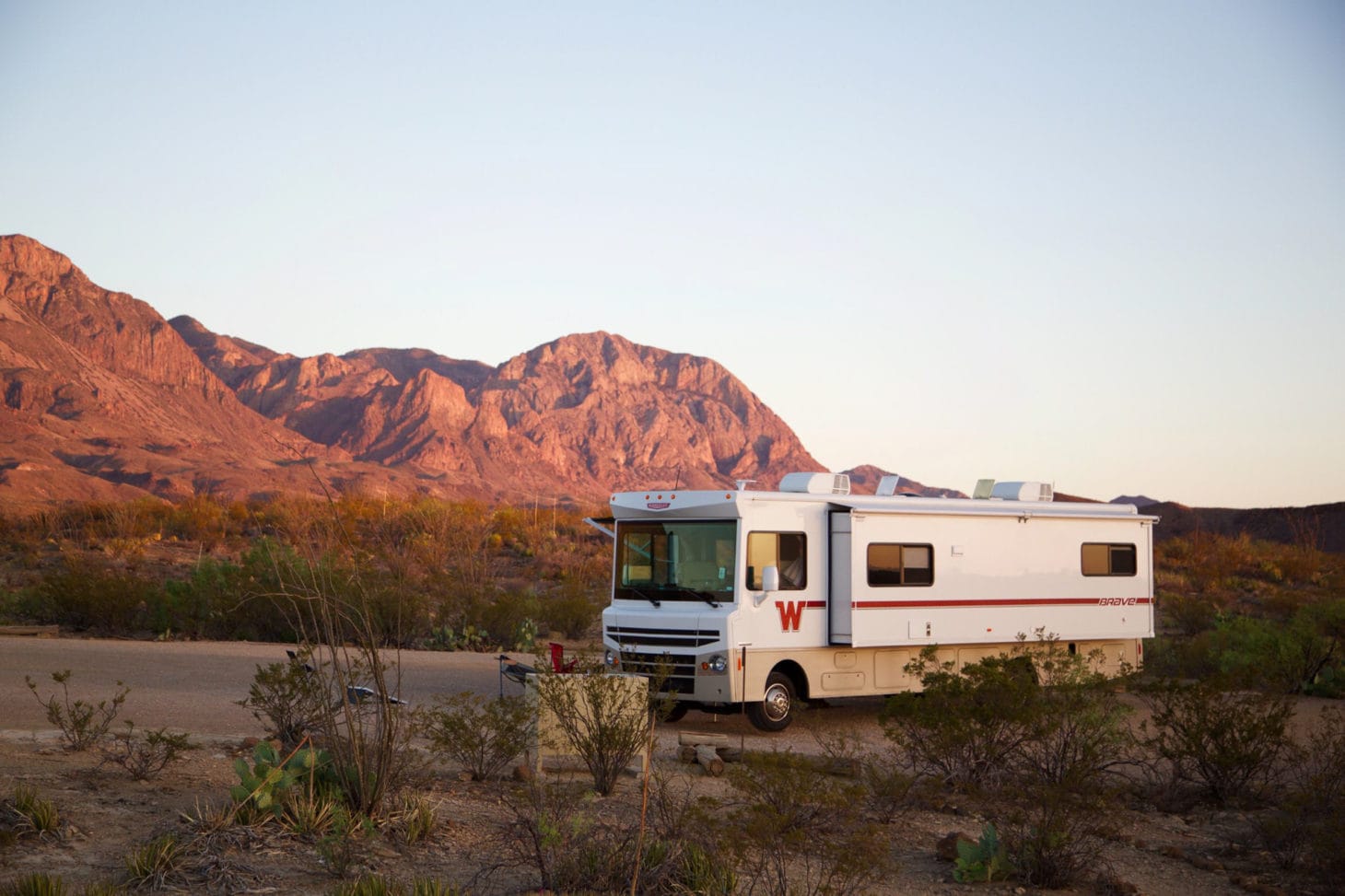
Boondocking on Public Land
When it comes to boondocking on BLM land or national forest land, areas sometimes close for misuse or overuse, so be sure to pay attention to any local signs that note if camping is not allowed. Follow signage and be respectful of your neighbors and the environment during your stay to keep these sites open for public use.
Many boondocking sites will offer exact coordinates so you can be certain you’re camping legally in the designated area. The goal when boondocking is to experience nature, not destroy it. Make sure that you use existing roads and stay only in designated camping areas.
As a general rule, you cannot boondock in national parks. National parks will have designated campgrounds (with or without hookups) for RVs or designated boondocking areas that require advance reservations. Boondocking areas in national parks are rare, but some parks, like Big Bend in Texas, do take reservations for boondocking.
Overnight Stops for Boondocking
Boondocking doesn’t only apply to camping on public lands. You may be looking for a quick overnight boondocking spot while you drive cross country.
You should avoid boondocking on streets, on the side of the road, or in business parking lots that do not explicitly allow overnight camping. Otherwise, you’ll likely get a knock on your window in the middle of the night and be asked to move along.
Many businesses do allow overnight camping. Walmart, Costco, Cracker Barrel, Kmart, and Flying J Travel Centers are known to allow boondocking for RVers. Note that this isn’t true for all locations, so always call ahead to ask. A handful of states allow overnight RV parking at rest areas, but in most parts of the U.S., this is a no-go. This is another reason to double-check with boondocking apps before you park for the night.
Boondocking Apps and Websites
Here’s a useful list of boondocking resources to help you find legal and safe places to boondock.
Campendium
This website has a huge database of different campsites, plus reviews, pricing details, and photos. You can even filter your search for “free camping.”
Reviews note cell signal strength, the latest pricing, tips for navigating to off-the-beaten-path sites, and even include photos. Boondockers can use it for research when camping on BLM or national forest land. Campendium also lists local dump stations and water fills.
Allstays App
This app costs $10, but pays for itself in one night of free camping. It keeps an up-to-date boondocking directory and is geared toward convenient and cost-effective overnight boondocking sites rather than destinations in remote and natural settings. The app is most useful to find Walmart, Kmart, Lowe’s, and other business parking lots that allow overnight camping.
US Public Lands App
This app was built by RV bloggers Technomadia to help boondockers find BLM and U.S. Forest Service land where you can camp for free. The app currently costs $3 and provides details on public lands, as well as how to know if you’re accidentally trespassing on private land.
Boondockers Welcome
If you want to boondock at someone’s house or property—commonly referred to as moochdocking— join Boondockers Welcome to find driveway camping. Many of the hosts who list a property on Boondockers Welcome are RVers themselves. The membership costs $50 annually and it’s expected that you give something to your hosts to thank them for your stay.
Harvest Hosts
Harvest Hosts is a program where you pay a membership fee to receive access to free camping at vineyards, wineries, breweries, distilleries, farms, and local attractions across the U.S.
Our Top 7 Boondocking Essentials
If you have a rig with solar panels, an inverter, and batteries, you’re almost ready to go off-grid. There are a few extra pieces of boondocking gear and equipment you might want to invest in to make the adventure possible.
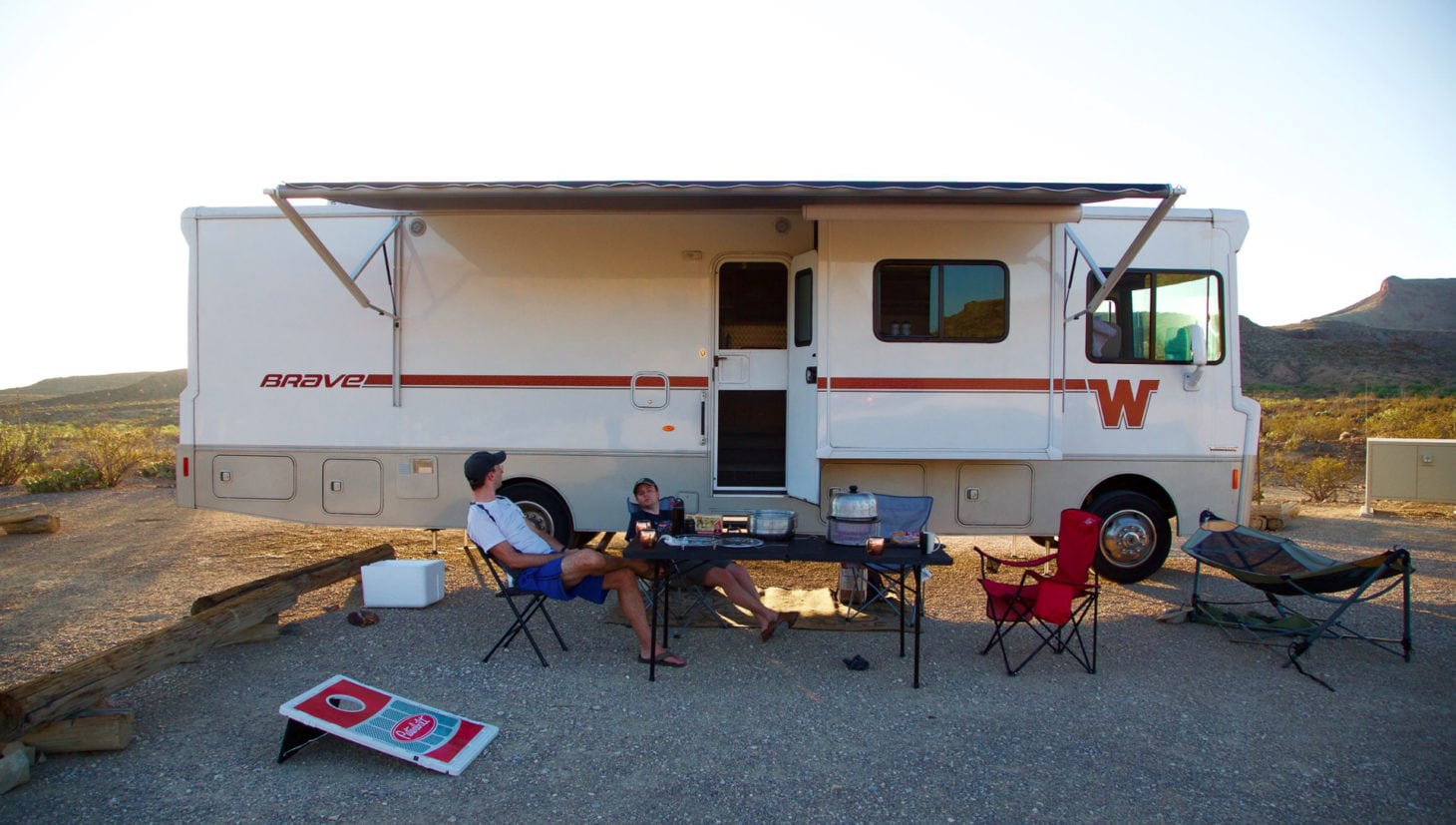
1. Water Bladder
This is the easiest way to top off your water tank without having to drive your RV to a fill station. You’ll also want to pick up a water pump to transfer the water from the bladder into your tank.
2. Biodegradable Soaps
With an outdoor shower, using soaps (and other toiletries) that will not negatively impact the environment is a must.
3. Composting Toilet
To save on water and eliminate the need to dump your black tank, consider replacing your existing RV toilet with a composting toilet.
4. Water Filter
When you’re getting your water from various sources, it’s important to filter the water multiple times. This can be done while filling using a hose connected filter, and also with a filtered water pitcher for drinking water.
5. Leveling Blocks
Always keep leveling blocks on hand to smooth out any mildly uneven terrain. This will help prevent undue stress on the body of your RV as well as keep interior machinery running smoothly throughout your boondocking stay.

6. Generator
If your RV doesn’t have one built-in, a generator can shoulder higher-consumption appliances like your microwave, oven, and air conditioner.
7. Bug Spray
Be sure to stock up on bug spray and be aware of insects that can cause harm or carry disease, including ticks, mosquitoes, venomous spiders, and anything that stings.
Whether you’re boondocking just for a weekend or longer, preparing to properly boondock takes time. Use trusted sources to find boondocking areas, read reviews, check conditions, and camp safely.
Boondocking Gear We Recommend:
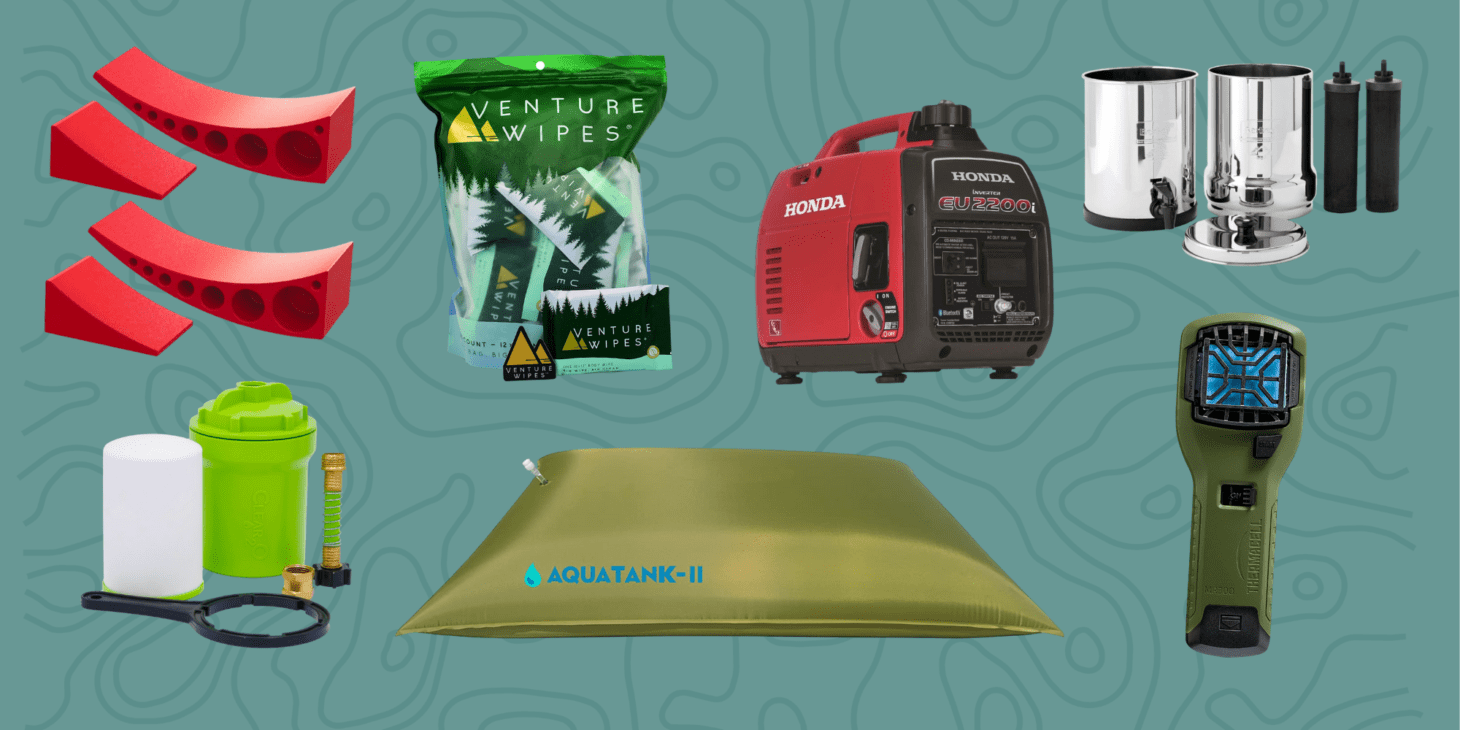
- Water Storage Tank Bladder
- Venture Wipes Biodegradable Outdoor Shower
- Honda Generator
- DirtGuard Sediment Pre-Filter
- Travel Berkey Water Purification System
- Camper Leveler, Chock Kit
- Portable Mosquito Repeller
This article has links to products that were carefully selected by our editors. We may earn commission on your purchases from these links. Visit this page for the full details of our affiliate marketing policy.
